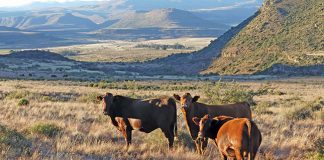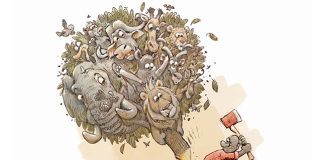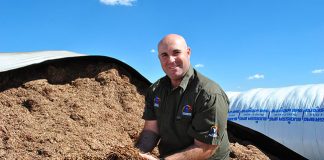
Photo: Wikimedia Commons
In many respects, agriculture in general, and farming in particular, are peculiar sectors of the economy. Farmers have to solve diverse challenges, as well as manage and mitigate countless threats, many of which present existential risk.
In Part 1 of this series of articles, I shall discuss farming as a pioneering venture, then consider some of the less obvious risks facing sheep farmers in particular. Many of the risks faced daily by farmers threaten the very existence of farms as going concerns, together with the livelihoods of entire farming communities.
This permanent state of pioneering, of being at the frontier of food production, is what makes the business of farming uniquely high-risk.
Farming is a frontline business in the sense that it alone has to mitigate and manage the most serious risks encountered through the total value chain of the production of food products and many other products used in commerce and industry.
Security risks
Consider the significant difference in the nature, scope and scale of security risks faced by, for example, a retail butchery compared with those of the farmer producing the meat, and the lengths and costs to which the farmer must go to mitigate security risks.
These facts about the business of farming make risk mitigation a worthwhile subject for serious consideration. However, the farmer should not end with the mitigation of risk, but persevere with testing innovative solutions that have the potential to reduce the pressures exerted by these risks on the farming operation.
From my research, it is clear that the failure of farmers to adequately prepare for and reduce the impact of key existential risks far outweighs any benefits that could accrue from the correct preparation for most farming opportunities.
For example, the benefits of improved farm security and reduced predation brought about by better fencing and physical patrols will quickly be undone if water security is compromised, or if firebreaks prove to be ineffective.
The cost of widespread, uncontrolled fire or loss of access to water, as examples of high-priority, existential risks, would negate the benefits of many quality decisions in areas which expose the farm and the farmer to lesser degrees of risk.
The prioritising, mitigation and management of risks, coupled with the search for innovative solutions to them, must be considered a primary discipline for farmers. I now turn my focus to the risks coupled with a specific farming model: free-range sheep farming, either for wool or mutton.
As with any private-sector business, the primary objective of the sheep farmer is firstly to make a profit, and then to improve efficiencies and grow the operation so as to maximise these profits. Simply stated, the farmer needs to sell the mutton or wool produced for a higher price than the total cost of production, including risk mitigation costs, legislated taxes, and a margin that brings rewards for the risks taken.
Losses in a business come about when the owner, management team and staff are unable, unwilling or unprepared to mitigate and manage the risks facing the business.
Lesser known risks
For farmers, and specifically sheep farmers, these risks include the following less obvious examples:
- Compromised or absent immunity to seasonal parasites, either drought/dry condition organisms or those prevalent during wetter seasons. Consider a current production flock, born in the Camdeboo in 2020 during serious drought conditions to ewes that had also experienced drought throughout most of their lives. The immunity of this flock will tend to protect it against dry-weather parasites, as these will have been all they had to deal with, as did their parent ewes. With the drought having broken in 2023, the second-generation ewes of this flock, when they lamb, will produce offspring with relatively poor resistance to wet-weather parasites.
If no risk mitigation strategies are put in place by the farmer, the mortality rate of these immune-compromised lambs could reach critical levels in the first year due to infection by wet-weather parasites, against which they will have inherited little or no immunity or resistance. - Changes in consumer buying patterns, unexpected or anticipated, present risks to the farmer that are difficult to mitigate against in the short and medium terms, as these most often require changes to farming practices, re-education and a high degree of innovation. Consider, for example, the impact that the vegetarian movement of the past 20 years has had on the consumption of animal protein in general and red meat in particular.
- Infestation of introduced and exotic plants, especially the various cactus varieties, with the associated impacts on grazing, carrying capacity, water usage, animal health, and relationships with neighbours.
- Inadvertent and unforeseen introduction of inferior-quality genes into the productive flock through artificial insemination programmes, using unverified sperm.
- Too narrow a view of the impact of legislative costs, including taxes and fees, veterinary and other animal health and safety requirements, and costs of the production value chain and cycles.
- Poor or absent estate planning for the inheritance of the farm. Too often, the commercial viability of the inherited farm is compromised due to the dilution of the estate’s capital base, division of the total hectares available, infighting among beneficiaries, and the payment of onerous estate duties and other fees.
- So-called black swan events, now happening in many Karoo farming districts, with the erection of wind-farms and cement platforms for the turbines and other required infrastructure. There is a very real risk that over the next decade, due to human error, equipment failure or accidents, toxic cement dust could be blown from these sites onto the surrounding grazing land and will find its way into the water sources and water table. Undoubtedly, animal and plant health issues will be an outcome of cement dust entering the ecosystem.
- Volatility of the differential within the grading metric of mutton and lamb prices. Consider, for example, that the producer price of A2/ A3 grade mutton in the first quarter of 2017 was R58,60/ kg, and this grade now receives R82,40/ kg, an increase of almost 41%, whereas AB2 grade increased by 35% over the same period, and C2/C3 rose by almost 40%.
- Furthermore, the continued aggressive support of imported mutton by many of the role players in the industry, as well as the dumping of foreign-sourced wool, mutton and lamb, priced well below the local production prices, have contributed significantly to price insecurity for local farmers.
Obvious risks
The following lists the more obvious risks facing farmers:
- Water scarcity, quality, security and accessibility;
- Poor timing, either too late or too early, of a lambing season or shearing cycles;
- Inferior quality, damaged, absent or inadequate fencing and other security measures;
- Persistent lack of genetic diversity in production flocks;
- The impact of the weak rand, especially with regard to fuel costs and imported medications;
- Parasite resistance to administered synthetic medications and preparations;
- Inferior time management of key functions and the risks resulting in not all priorities being addressed;
- Poor administration, accounting, record- keeping and tracking of statistics of the farming operations. Consider, for example, the challenges of successfully lambing with ewes carrying the genes for twins and triplets. These will be known to experienced farmers. If careful record-keeping, day-books and flock statistics are maintained, the novice farmer will have access to data to ensure that risk mitigation strategies and practices can be put in place to ensure that twins and triplets survive.
- Gaps in the farmer’s knowledge of the carrying capacity of the veld when affected by newly introduced grass varieties, encroachment of invasive vegetation, predation patterns and densities, grazing by competing wild herbivores, the impact of seasonal insect populations on the grazing, the long-term negative impacts of pesticide and herbicide on grazing, water sources and toxicity levels, the extent of soil erosion caused by wind, water, and poor land management;
- Lack of knowledge of broad economic principles and measures, including market supply and demand metrics ahead of changes in consumption trends.
Due to the numerous risks associated with the production of food and fibre, farmers need to develop strategies and search for innovative solutions to mitigate these risks.
Existential risks to farming communities, farms as businesses, and sheep flocks as production units rank as the most important of the risks faced by farmers. These include issues such as comprehensive security, especially physical, personal security and water security, fire risk, expropriation of land, widespread flock disease, and market risks such as price volatility and the collapse of the demand side of the economy.
In the articles of this series to follow, I will discuss the need for continued and sustained attention to be paid to the creation or discovery, and testing of possible solutions aimed at resolving the risks faced by farmers. I will also expand on how innovation lies at the heart of a matrix consisting of the sheep farming value chain and the key risks associated with each of the elements of production.
Email PJ Mommsen at [email protected].











